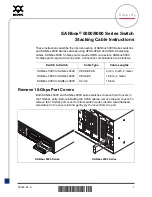
8
Introduction to the Extricom Series Wireless LAN System
WMM (based on 802.11e standard) enhances the DCF by defining an Enhanced Distributed
Channel Access (EDCA). EDCA specifies different fixed and random wait times for the four
prioritization categories to provide more favorable network access for applications that are less
tolerant of packet delays. Devices that have less time to wait have a better chance of being able to
transmit than those that have a longer wait. In order of highest priority, the access prioritization
categories are
voice, video, best effort
and
background
.
By default, these four WMM prioritization categories are statically mapped to Ethernet 802.1p
prioritization tags to allow consistent QoS across wireless and wired network segments. Flow
arriving from the wired network tagged with 802.1p priority is mapped to the appropriate Access
category, while WMM flow arriving from the wireless medium is encapsulated and tagged with
the appropriate 802.1p priority.
The back-off timing for each access category consists of a fixed period called the Arbitrary Inter-
Frame Space Number (AIFSN) followed by a random period called the Contention Window
(CW), both specified in multiples of the slot time. The CW maintains the DCF random back-off
component to help avoid collisions of packets from the same access category. The CW range
doubles each time there is a collision (starts CWmin up to CWmax) and is reset to its minimum
value after a successful transmission.
EDCA uses a mechanism called a Transmit Opportunity (TXOP) – a bounded time interval during
which a station can send as many frames as possible, but the transmission time must not extend
beyond the maximum duration of the TXOP. Each priority level is assigned a TXOP, and this
mechanism prevents low-speed stations from spending too much time using the media when other
clients (including those with traffic in higher priority queues) are waiting.
Another mechanism introduced by WMM is per-access category Acknowledgment policy
(Normal or No ACK). Normal means that an acknowledge packet is returned for every packet
received. This provides a more reliable transmission, but increases traffic load, which decreases
performance. However, one may choose to cancel the acknowledgement by selecting "No ACK"
for each access category. This can be useful for Voice, for example, where speed of transmission
is important, and packet loss is tolerable to a certain degree.
IPv6 support
–
The Extricom Series Switch family supports IPv6 pass-through. For example,
DHCP requests in IPV6 format are passed between the WLAN and the LAN.
Blanket balancing
–
The switches automatically perform load balancing, distributing the traffic
evenly over the different channels.
Low-density parity-check (LDPC)
– Extricom Series Access Points support LDPC which
improves reception of packets over a noisy channel.
Space–time block coding (STBC)
– Extricom Series Access Points support STBC which
improves the ability to transmit packets over a noisy channel.
Overview of the Switch Platforms
The Extricom Series WLAN switches are connected to Extricom Series APs to form an Extricom
WLAN. The Extricom Multi Series (MS) is a high-performance switch hardware platform, and is
software-configurable to support a range of wireless and networking functions in an Extricom
WLAN System.
















































